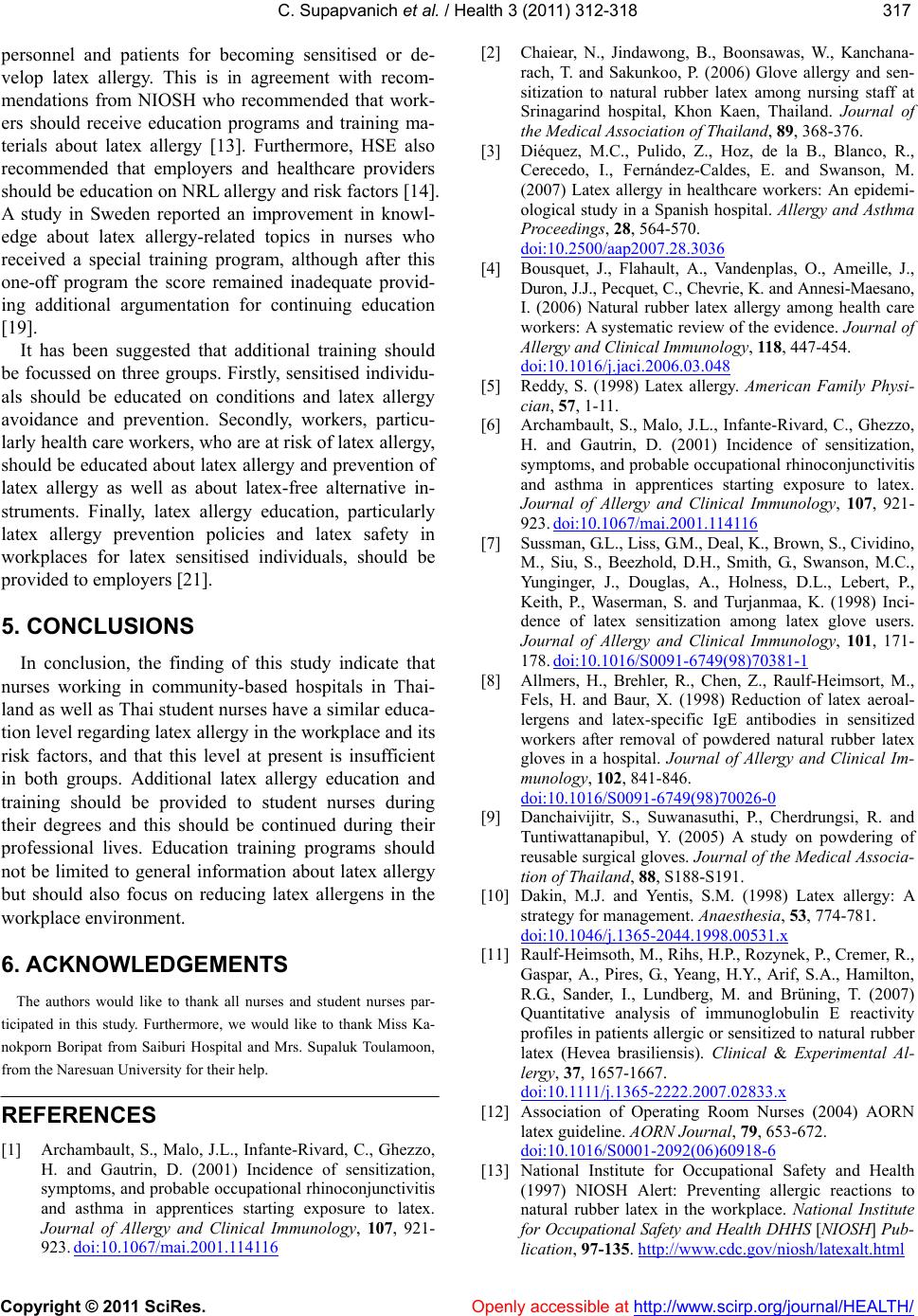
C. Supapvanich et al. / Health 3 (2011) 312-3 18
Copyright © 2011 SciRes. Openly accessible at http://www.scirp.org/journal/HEALTH/
317317
personnel and patients for becoming sensitised or de-
velop latex allergy. This is in agreement with recom-
mendations from NIOSH who recommended that work-
ers should receive education programs and training ma-
terials about latex allergy [13]. Furthermore, HSE also
recommended that employers and healthcare providers
should be education on NRL allergy and risk factors [14].
A study in Sweden reported an improvement in knowl-
edge about latex allergy-related topics in nurses who
received a special training program, although after this
one-off program the score remained inadequate provid-
ing additional argumentation for continuing education
[19].
It has been suggested that additional training should
be focussed on three groups. Firstly, sensitised individu-
als should be educated on conditions and latex allergy
avoidance and prevention. Secondly, workers, particu-
larly health care workers, who are at risk of latex allergy,
should be educated about latex allergy and prevention of
latex allergy as well as about latex-free alternative in-
struments. Finally, latex allergy education, particularly
latex allergy prevention policies and latex safety in
workplaces for latex sensitised individuals, should be
provided to employers [21].
5. CONCLUSIONS
In conclusion, the finding of this study indicate that
nurses working in community-based hospitals in Thai-
land as well as Thai student nurses have a similar educa-
tion level regarding latex allergy in the workplace and its
risk factors, and that this level at present is insufficient
in both groups. Additional latex allergy education and
training should be provided to student nurses during
their degrees and this should be continued during their
professional lives. Education training programs should
not be limited to general information about latex allergy
but should also focus on reducing latex allergens in the
workplace environment.
6. ACKNOWLEDGEMENTS
The authors would like to thank all nurses and student nurses par-
ticipated in this study. Furthermore, we would like to thank Miss Ka-
nokporn Boripat from Saiburi Hospital and Mrs. Supaluk Toulamoon,
from the Naresuan University for their help.
REFERENCES
[1] Archambault, S., Malo, J.L., Infante-Rivard, C., Ghezzo,
H. and Gautrin, D. (2001) Incidence of sensitization,
symptoms, and probable occupational rhinoconjunctivitis
and asthma in apprentices starting exposure to latex.
Journal of Allergy and Clinical Immunology, 107, 921-
923. doi:10.1067/mai.2001.114116
[2] Chaiear, N., Jindawong, B., Boonsawas, W., Kanchana-
rach, T. and Sakunkoo, P. (2006) Glove allergy and sen-
sitization to natural rubber latex among nursing staff at
Srinagarind hospital, Khon Kaen, Thailand. Journal of
the Medical Association of Thailand, 89, 368-376.
[3] Diéquez, M.C., Pulido, Z., Hoz, de la B., Blanco, R.,
Cerecedo, I., Fernández-Caldes, E. and Swanson, M.
(2007) Latex allergy in healthcare workers: An epidemi-
ological study in a Spanish hospital. Allergy and Asthma
Proceedings, 28, 564-570.
doi:10.2500/aap2007.28.3036
[4] Bousquet, J., Flahault, A., Vandenplas, O., Ameille, J.,
Duron, J.J., Pecquet, C., Chevrie, K. and Annesi-Maesano,
I. (2006) Natural rubber latex allergy among health care
workers: A systematic review of the evidence. Journal of
Allergy and Clinical Immunology, 118, 447-454.
doi:10.1016/j.jaci.2006.03.048
[5] Reddy, S. (1998) Latex allergy. American Family Physi-
cian, 57, 1-11.
[6] Archambault, S., Malo, J.L., Infante-Rivard, C., Ghezzo,
H. and Gautrin, D. (2001) Incidence of sensitization,
symptoms, and probable occupational rhinoconjunctivitis
and asthma in apprentices starting exposure to latex.
Journal of Allergy and Clinical Immunology, 107, 921-
923. doi:10.1067/mai.2001.114116
[7] Sussman, G.L., Liss, G.M., Deal, K., Brown, S., Cividino,
M., Siu, S., Beezhold, D.H., Smith, G., Swanson, M.C.,
Yunginger, J., Douglas, A., Holness, D.L., Lebert, P.,
Keith, P., Waserman, S. and Turjanmaa, K. (1998) Inci-
dence of latex sensitization among latex glove users.
Journal of Allergy and Clinical Immunology, 101, 171-
178. doi:10.1016/S0091-6749(98)70381-1
[8] Allmers, H., Brehler, R., Chen, Z., Raulf-Heimsort, M.,
Fels, H. and Baur, X. (1998) Reduction of latex aeroal-
lergens and latex-specific IgE antibodies in sensitized
workers after removal of powdered natural rubber latex
gloves in a hospital. Journal of Allergy and Clinical Im-
munology, 102, 841-846.
doi:10.1016/S0091-6749(98)70026-0
[9] Danchaivijitr, S., Suwanasuthi, P., Cherdrungsi, R. and
Tuntiwattanapibul, Y. (2005) A study on powdering of
reusable surgical gloves. Journal of the Medical Associa-
tion of Thailand, 88, S188-S191.
[10] Dakin, M.J. and Yentis, S.M. (1998) Latex allergy: A
strategy for management. Anaesthesia , 53, 774-781.
doi:10.1046/j.1365-2044.1998.00531.x
[11] Raulf-Heimsoth, M., Rihs, H.P., Rozynek, P., Cremer, R.,
Gaspar, A., Pires, G., Yeang, H.Y., Arif, S.A., Hamilton,
R.G., Sander, I., Lundberg, M. and Brüning, T. (2007)
Quantitative analysis of immunoglobulin E reactivity
profiles in patients allergic or sensitized to natural rubber
latex (Hevea brasiliensis). Clinical & Experimental Al-
lergy, 37, 1657-1667.
doi:10.1111/j.1365-2222.2007.02833.x
[12] Association of Operating Room Nurses (2004) AORN
latex guideline. AORN Journal, 79, 653-672.
doi:10.1016/S0001-2092(06)60918-6
[13] National Institute for Occupational Safety and Health
(1997) NIOSH Alert: Preventing allergic reactions to
natural rubber latex in the workplace. National Institute
for Occupational Safety and Health DHHS [NIOSH] Pub-
lication, 97-135. http://www.cdc.gov/niosh/latexalt.html